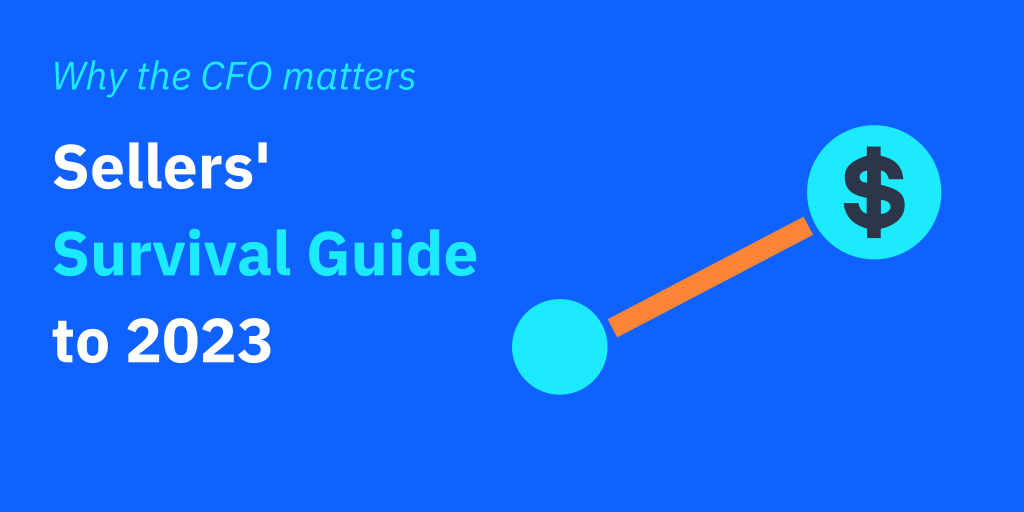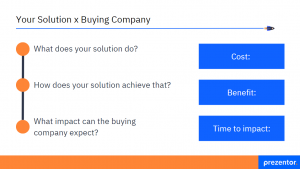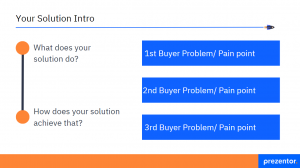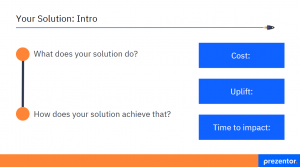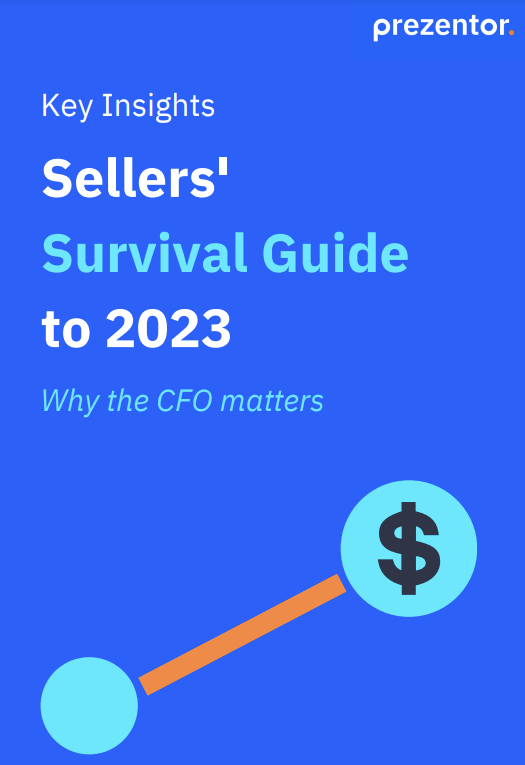How to create a business case that gets approved
What is a business case and why is it important for sellers?
A business case is a document that highlights the benefits of a project or investment, in order to get the approval of decision-makers. As they are normally created internally within a company, the importance of a business case for sellers is often overlooked or underestimated. Sellers already have plenty to keep them busy, with challenging quotas to achieve, leads to chase, CRM data to update… so who can blame them for thinking it’s not their job to write a business case? The truth is, you cannot rely solely on your champion to promote your solution in the best light and get the approval of the decision-makers. Your champion often does not even know exactly what the process is for approving a purchase in their company, nor all the stakeholders that might be involved in it. This is why sellers need to learn how to write a business case that gets approved and educate their champion on how to best present it. In this article, you can discover the main challenges sellers face when creating a business case, learn how to create a perfect business case, and find business case templates that you can customize and use to win more deals.
Main challenges in creating a successful business case
The first obstacle, as already mentioned, is underestimating the importance of the business case in sales. Due to the current economic climate and the growing number of stakeholders involved in buying committees, B2B sales are more challenging than ever.
A study conducted by Prezentor in 2023 found that financial stakeholders, such as CFOs, are increasingly involved in purchase decisions and are now required to give their approval for almost every investment, no matter the size. One of the CFOs who was interviewed for the study stated: “no matter if the investment is budgeted for or not, I still have to assess if it has a direct impact on our business and approve it”. That is why providing your champion(s) with a strong business case that highlights the benefits and business impact your solution creates is important for you to get the deal signed.
Once we’ve established the importance of creating a business case in sales, the problem of time investment remains. It takes time to gather all the information needed, plus it can be especially difficult to get insights into the buyer’s main goals and challenges. Your point of contact may simply not know what the business-level goals are, or they may consider them as confidential information that they are not allowed to share. If that is the case, it could be a good idea to work together with your customer success team. As they are responsible for helping customers achieve their goals, they might have a better idea of what those goals typically are and how your solution helps your customers achieve them.
Another idea could be to try and involve decision-makers of the executive level early on in the sales process. Even though that can be quite challenging too, depending on the size of the buyer’s company, it can give you direct feedback from the top and higher chances of winning the deal.
Information to gather for your business case
Before getting started with the business case, there is some information to gather from your buyer.
Goals & challenges. As discussed above, it may be not be easy, but discovering your buyer’s goals and pain points will give you the opportunity to present your solution in the best light. You will be able to put your offer into context, showing your buyer how the investment fits into their business strategy and how your solution can take them closer to achieving their goals or solving a challenge they are facing.
Purchase approval process. Try to find out what the process is to get your deal approved. Once you have the buy-in of your main contact, what are the next steps? Who needs to review and approve your business case? What do they care about? This is a great opportunity for you as a seller to prove your experience by outlining the typical process in the scoping phase and walking your buyer through it. Download this purchase process outline and use it in your next buyer meeting.
Resources available. Depending on what product or service you are selling, it might be useful to know the resources already available to your buyer. If, for example, you are selling software that integrates with the tech stack your buyer already owns, this will be a great advantage point for you to highlight, as it will speed up the implementation time.
What makes the perfect business case
There are a few considerations to make before writing a business case. Below we list a few tips to bear in mind to create the perfect business case.
Tailor to the main stakeholders. One of the key factors for a successful business case is personalization. Once you’ve found out who the main stakeholders are, who are involved in the deal’s approval process, try to learn what they base their decision on. CFOs, for example, want to know the financial implications, but also the potential risks that come with the purchase.
Focus on credibility. Always be transparent and realistic and provide context for the numbers you use. You should either quote reliable sources that have a track record and are universally considered trustworthy or, if you are providing data from your own records and studies, explain clearly how you obtained those numbers and provide proof of their accuracy.
Keep it short. No one has the time – nor the will – to read a lengthy and detailed business case. The trick is to find the right balance between providing all the necessary information and sticking only to what matters to your stakeholders.
Use the buyer’s numbers. When building a case for your solution, always use the numbers and data you gathered from the buyer. This will provide a high level of personalization and, therefore, a better customer experience. Additionally, you will make your case highly relevant by proving the value of your solution for the specific buyer.
Consider the format. Business cases come in several formats. They can be written as an executive summary, just a couple of slides that highlight the main points, a full deck of slides with all the information your buyer needs to know, and so on. Which format to use will depend on what you are selling and who you are selling to. If you have the possibility, consider using interactive presentations to communicate your pitch in the most efficient way and maximize buyer engagement.
Communicate necessity and urgency. To win deals in the current economic climate, it is not enough anymore for your solution to be perceived as a ‘nice to have’, but rather as a ‘must have’. A good way to build this perception could be to illustrate what would happen if the buyer didn’t purchase your solution. How much would they lose? What would they be missing out on? If the type of solution you are selling is currently popular within the buyer’s industry, you could share trend reports that show how many other companies are investing in this type of tools. This creates a sense of urgency, as the buyer will not want to fall behind their competitors.
What should be in a business case?
As already mentioned, business cases can vary greatly, both in format and in content. So, how do you choose what to include in your business case? First of all, consider who the business case is for – who will read it? Who needs to give their approval for the purchase? What do they need to know?
We can differentiate between low-level, medium-level, and executive buyers. If you only have the opportunity to create one business case for different levels of buyers, try to keep the information separate, so each decision-maker can choose to read the sections that are most relevant to them.
Low-level buyer
A low-level buyer would be the end user of your product or solution. The information you need to provide them with in order to win them over is mostly based on practical aspects, rather than on business-level advantages. The questions your business case will need to answer for them are:
- What are the product features?
- What advantages does it bring to their work life? (Does it improve productivity? Save time? Simplify complicated tasks? Help them achieve personal goals faster? Etc.)
- How easy is it to implement / learn to use?
Medium-level buyer
A medium-level buyer would be, for example, a department manager or team manager. A business case tailored to them will need to focus on the advantages your product brings on a department-level or team-level. The questions your business case will need to answer for them are:
- How can your product improve the efficiency of their team/department?
- What resources are required to implement it?
- How long will it take to implement?
How does it fit within the department’s strategy? Will it help achieve goals?
Executive buyer
Needless to say, a business case aimed at the executive buyer needs to be more detailed and focused on business-level impact. The amount of detail to provide will vary according to the size of investment, as well as the size of the buyer’s company. For example, a big company who is used to purchasing solutions regularly won’t need a lot of information for a small purchase, while a small or medium-sized business will be more likely to evaluate each purchase more carefully, especially in case of medium or major investments.
The questions they will be asking themselves while assessing your business case are:
- What are the costs?
- What short-term and long-term benefits does this investment bring to the organization?
- Does this fit within the business strategy?
- How long does it take to implement?
- What resources are required to implement?
- What is the short-term and long-term ROI?
- What are the potential risks?
- How feasible is it?
Bearing in mind that you need to keep the business case as short as possible, so you don’t steal too much time away from the executives’ busy schedules, here is a list of materials and information that might be relevant to include in your business case for the executive buyer:
- A cost-benefit analysis
- Time to implementation / full productivity
- Contract length
- Resources required for implementation
- ROI calculator
- Legal documentation, if relevant – e.g., GDPR compliance, ISO certifications, etc.
- Customer cases that prove feasibility and show how your product helped other businesses achieve their goals
Sometimes, it can also be useful to include a vendor comparison, especially if the market segment you operate in is crowded with similar solutions and you are in a position to prove that your product offers more advantages than your competitors’ or you operate at a better price point.
Business case templates
The content of your business case will also vary according to the investment size. Bigger investments will be assessed more carefully by the buyer, who will therefore need more detailed information.
Here are three business case templates we created according to the investment size. Download them for free and customize them (also bearing in mind the buyer level, as discussed in the previous section) to create a business case that gets approved.
Small investment template
Medium investment template
Major investment template
Final thoughts
The importance of writing a business case in sales is often underestimated, yet in 2023 sellers cannot solely rely on their champion to create a business case that gets approved by all decision-makers. Educating your champion and providing them with the materials needed for a successful business case will speed up your sales cycle, taking you one step closer to getting that signature on your deal.


